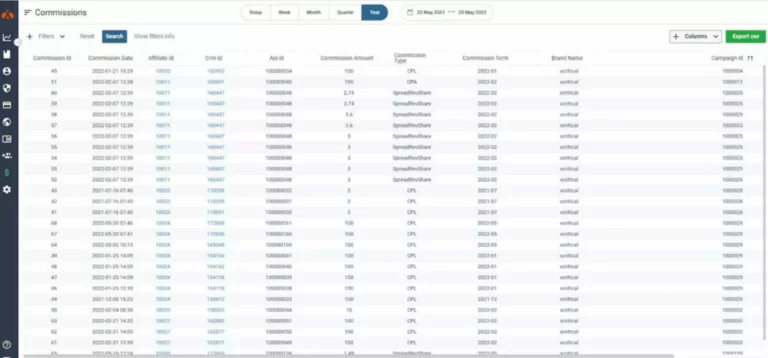Content
They can also help users generate and customize various reports and dashboards for liquidity management activities, which enhances reporting efficiency and transparency. This allows you to distinguish larger, individual orders from the rest of the liquidity, which typically consists of lots of smaller orders. Factors such as trading volume, market capitalization, and investor interest affect a stock’s liquidity. So, embrace liquidity not just as a number on your balance sheet, but as a guide on your path to financial success and stability. This ratio is crucial for a business such as a coffee shop’s financial health, because it reflects the immediate funds available to cover any pressing liabilities such https://www.xcritical.com/ as supplier payments, rent, or employee wages.

Risk Appetite Declines Across Derivatives Markets
“Return on liquidity soft solutions forex Equity” provides a general indicator of the level of earnings and operational cash flow a firm generates in relation to the cost of long term capital invested in the enterprise. As many entrepreneurs realize, “cash flow is king and queen” in a company’s financial management practices. But most traditional liquidity measures have inherent weaknesses, especially at privately held firms headed by entrepreneurs with little or no financial background. An alternative cash flow metric, the Net Balance Position (NBP) provides a simpler yet more effective way to measure the liquid situation of these firms.

Profitability Ratios vs. Liquidity Ratios
This route may not be available for a company that is technically insolvent because a liquidity crisis would exacerbate its financial situation and force it into bankruptcy. Through my expertise, I strive to empower individuals with the knowledge and tools they need to navigate the exciting realm Smart contract of digital assets. Whether you’re a seasoned investor or a curious beginner, I’m here to share valuable insights, practical tips, and comprehensive analyses to help you make informed decisions in the crypto space. The interface, while not immediately intuitive to the novice user, becomes incredibly powerful with familiarity, offering sophisticated tools for financial modeling, portfolio management, and risk analysis.
Option 3: Improve Working Capital Requirements
- However, unless the financial system is in a credit crunch, a company-specific liquidity crisis can be resolved relatively easily with a liquidity injection (as long as the company is solvent).
- (The Dry Bean Income Statement and Balance Sheets for 2000, 2001 and 2002 are presented in the Appendix section).
- However, it may also mean a company is trying to hold onto less cash and deploy capital more rapidly to achieve growth.
- Financial leverage, however, appears to be at comfortable levels, with debt at only 25% of equity and only 13% of assets financed by debt.
- Consistent liquidity ratio analysis is essential for monitoring ongoing liquidity risks.
- Choosing the right liquidity trackers depends on your investment strategy and specific needs.
Measuring liquidity involves analyzing different financial ratios that compare liquid assets to short-term liabilities. By the end, readers will understand how to evaluate their company’s liquidity position using the data and tools in QuickBooks. Tracking liquidity over time can help identify issues before they become urgent problems, supporting better cash flow planning.
For example, after BlackRock filed for a Bitcoin ETF, sentiment became more bullish, driving the Pull/Call ratio lower from 0.72 to 0.40. Following the market lows set in the wake of the FTX collapse, Open Interest started to climb in early 2023. For Options, open interest peaked during the March banking crisis when USDC experienced a depeg from $1. Ethereum futures open interest peaked around the Shanghai Upgrade, suggesting this was the last major speculative event for the asset. We can see that DeFi and GameFi tokens have performed relatively poorly (-17%) and (-20%) compared to the majors, whilst Liquid Staking tokens were somewhat better off (-7.7%). Across the board however, the downside price action was similiar or less severe than the downturns seen in March, April and June.
Quantitative Brokers (QB) is a global financial technology company, provides advanced algorithms and data-driven pre- and post-trade analytics to clients in the futures, options, and interest rate markets. The company is built on a research-driven culture, market microstructure know-how, and algorithmic engineering expertise. QB continually develops and innovates an evolving suite of products to reduce and measure implicit trading costs for its clients. Headquartered in midtown Manhattan, QB has branch offices in London, Sydney, and Chennai.
Finally, don’t shy away from using the community features offered by some platforms. Learning from others can be a great way to hone your skills and understanding of market liquidity. Regular monitoring of liquidity can help you spot trends and identify potential opportunities or risks.
This week, volume is even lower at $8.3B/day, suggesting liquidity continues to drain from the space. “The Liquidity Tracker provides guidance and visibility across multiple markets,” said Robert Almgren, QB’s Co-Founder and Chief Scientist. “We are very transparent with our clients and strongly believe the wider trading community can benefit from this open-source tool.” Businesses need enough liquidity on hand to cover their bills and obligations so that they can pay vendors, keep up with payroll, and keep their operations going day in and day out. However, unless the financial system is in a credit crunch, a company-specific liquidity crisis can be resolved relatively easily with a liquidity injection (as long as the company is solvent). On the other hand, seasoned investors or financial institutions might lean towards more comprehensive platforms like Bloomberg Terminal or Eikon.
Additionally, liquidity management tools ensure they meet short-term debt obligations while simultaneously seizing growth opportunities. For example, if your ratio drops from 1.2 to 0.8 over two years, it may suggest your business’s liquidity position is worsening. Quick ratio analysis provides an early warning sign to potential cash flow problems down the road. Reviewing trends and benchmarks helps businesses proactively manage cash flow, debt obligations, and financial risk. Monitoring trends in the overall liquidity ratio over time can also give insights into the financial health and liquidity of a company. A declining ratio may indicate potential issues in paying off short-term debts as they become due.
In contrast to liquidity ratios, solvency ratios measure a company’s ability to meet its total financial obligations and long-term debts. Solvency relates to a company’s overall ability to pay debt obligations and continue business operations, while liquidity focuses more on current or short-term financial accounts. The overall liquidity ratio measures a company’s ability to pay off its short-term liabilities with its current assets. QuickBooks makes it easy to calculate key liquidity ratios like the current ratio to assess the short-term financial health and liquidity of your business.
Other liquid assets include stocks, bonds, and other exchange-traded securities. Tangible items tend to be less liquid, meaning that it can take more time, effort, and cost to sell them (e.g., a home). These liquid stocks are usually identifiable by their daily volume, which can be in the millions or even hundreds of millions of shares.
Liquidity ratio analysis may not be as effective when looking across industries as various businesses require different financing structures. Liquidity ratio analysis is less effective for comparing businesses of different sizes in different geographical locations. It’s crucial to remember that different platforms may excel in various areas – whether it’s the range of assets they cover, the depth of their data, or their ease of use. Thus, your choice should align with your investment goals and comfort level with technology. The interface is highly customizable, allowing users to create dashboards that cater to their specific needs.
While having a liquidity trackers is beneficial, it’s equally important to understand how to make the most of it. Most platforms offer tutorial guides and resources to help users navigate their systems. Liquidity, in simplest terms, refers to the ease with which an asset can be converted into cash without significantly impacting its price. It’s a fundamental concept in the financial market, ensuring transactions occur smoothly and efficiently. When liquidity is high, markets are robust and resilient, making it easier for investors to buy and sell assets at fair prices. In this article, we shared the top five liquidity pool (LPs) trackers and analytic service providers.
Cash is the most liquid asset, followed by cash equivalents, which are things like money market accounts, certificates of deposit (CDs), or time deposits. Marketable securities, such as stocks and bonds listed on exchanges, are often very liquid and can be sold quickly via a broker. If markets are not liquid, it becomes difficult to sell or convert assets or securities into cash.
